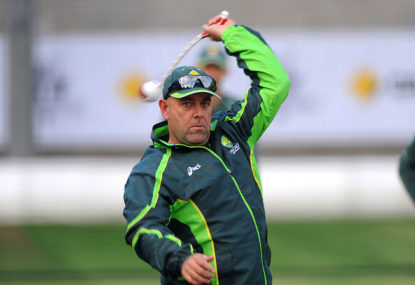Head and shoulders above: Why Trav is the key to Australia's T20 World Cup success
In just under three weeks, the 2024 Men’s T20 World Cup will commence in Texas as the United States face off against Canada in…

Darren Lehman took the reigns of an Australian cricket team in a harrowing state in June 2013. Almost 14 months on, the side looks a shade of its abject former self and looks set to return to an era of winning.
While comprised of similar personnel to that of the ill-fated 2013 Champions Trophy, the Australian outfit that graced a sun-soaked Harare Sports Park on Monday against Zimbabwe played its cricket in a completely different manner.
It was clear from Lehmann’s first press conference that Australia was going to approach all facets of the game in an attacking and aggressive fashion. It was going to take more than just a change of ideals to reverse the fortunes of a team in crisis.
Execution of skills, particularly in high-pressure moments, was a must going forward. But it was more than just an execution of skills. After all, these players are professionals, of course they had the skill.
Lehmann has instilled a hunger and desire to win. He’s instilled a great sense of pride in representing Australia, and while you can see it in the attacking, big-hitting batting and the aggressive, body-line bowling, there is nowhere you can see it more than in the fielding where Australia hunt as a pack.
The 2013 Champions Trophy saw Australia hit rock bottom with their fielding. Dropped catches, over throws and schoolboy errors were a plenty. The fielding standards, that teams led by Steve Waugh and Ricky Ponting prided themselves on, had disappeared.
Lehmann was a member of these teams and, along with the recently departed Mike Young and newly appointed fielding coach Greg Blewett, he is ensuring Australia has hunger and passion in the field. The desire to stop every single run reflects the commitment Australia has to regaining complete dominance in their national sport.
After 146 days since Australia’s last international match in any format, there has been a lot to like about their clinical performance in the first ODI against Zimbabwe. The aggression in every facet of Australia’s play was on show for all to see against a visibly weaker opposition.
There was plenty to make Lehmann happy. A brilliant opening stand from Aaron Finch and Brad Haddin, Mitchell Marsh making a fist of his role at first drop, more explosive batting from Glen Maxwell, tight fast bowling from Mitchell Johnson, a return to the ODI scene for Nathan Lyon and even a few wickets for Steven Smith were all highlights.
But it was a piece of fielding that reflected Australia’s aforementioned, newfound hunger to win that may have had the coach most impressed.
It was in the ninth over, and Zimbabwean Sikandar Raza crunched one off the back foot that was headed for the boundary. Lyon and Maxwell gave chase, Lyon managed to flick the ball just before the boundary. In the process though he flicked the ball up rather than back, and it took a diving Maxwell to flick the ball back over the boundary and in field, saving a certain boundary.
It’s this incredible desperation to salvage every single run in the field, and the killer instinct approach, that Lehmann knows will play a large role in returning Australia to its dominant position of years gone by.
A similar effort drew his praise in the earlier Tests this year against South Africa. South Africa were nine wickets down, well short of Australia’s target, and a loss was inevitable. Vernon Philander played a shot that seemed destined to roll to the boundary, whether it went for four or not would have very little influence on the result of the match.
But there was Australia’s oldest and arguably slowest member, Chris Rogers, racing to save a boundary. After the game the coach pointed out this effort, and praised how it was efforts like this that indicated the team had the “hunger and drive” to represent Australia, day in, day out.
The similar effort from Lyon and Maxwell on Monday would have certainly captured Lehmann’s attention, and will have given him solace in knowing that the team is heeding his directions. Australian fielding reached its lowest ebb under Mickey Arthur, and Lehmann made it clear from the outset that the approach to fielding reflects the way in which any side wants to play.
The desperation in the field against a minnow shows Australia will have no mercy in its conquest to reach the top, and along the way will evoke memories, or maybe even eclipse, the standards in the field set by Waugh and Ponting’s sides of the golden era.